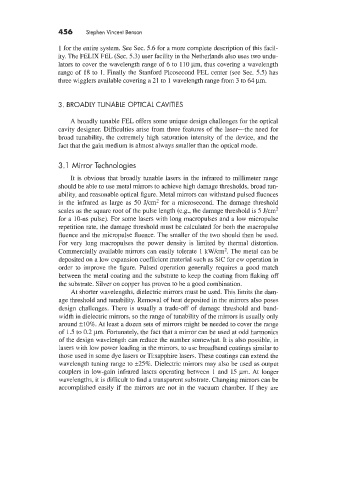Page 496 - Tunable Lasers Handbook
P. 496
456 Stephen Vincent Benson
1 for the entire system. See Sec. 5.6 for a more complete description of this facil-
ity. The FELIX FEL (Sec. 5.3) user facility in the Netherlands also uses two undu-
lators to cover the wavelength range of 6 to 110 pm, thus covering a wavelength
range of 18 to 1. Finally the Stanford Picosecond FEL center (see Sec. 5.5) has
three wigglers available covering a 21 to 1 wavelength range from 3 to 64 pm.
3. BROADLY TUNABLE OPTICAL CAVITIES
A broadly tunable FEL offers some unique design challenges for the optical
cavity designer. Difficulties arise from three features of the laser-the need for
broad tunability, the extremely high saturation intensity of the device, and the
fact that the gain medium is almost always smaller than the optical mode.
3.1 Mirror Technologies
It is obvious that broadly tunable lasers in the infrared to millimeter range
should be able to use metal mirrors to achieve high damage thresholds, broad tun-
ability. and reasonable optical figure. Metal mirrors can withstand pulsed fluences
in the infrared as large as 50 J/cm' for a microsecond. The damage threshold
scales as the square root of the pulse length (e.g., the damage threshold is 5 J/cm'
for a 10-ns pulse). For some lasers with long macropulses and a low micropulse
repetition rate. the damage threshold must be calculated for both the macropulse
fluence and the micropulse fluence. The smaller of the two should then be used.
For very long macropulses the power density is limited by thermal distortion.
Commercially available mirrors can easily tolerate 1 kW/cm'. The metal can be
deposited on a low expansion coefficient material such as Sic for cw operation in
order to improve the figure. Pulsed operation generally requires a good match
between the metal coating and the substrate to keep the coating from flaking off
the substrate. Silver on copper has proven to be a good combination.
At shorter wavelengths, dielectric mirrors must be used. This limits the dam-
age threshold and tunability. Removal of heat deposited in the mirrors also poses
design challenges. There is usually a trade-off of damage threshold and band-
width in dielectric mirrors, so the range of tunability of the mirrors is usually only
around *lo%. At least a dozen sets of mirrors might be needed to cover the range
of 1.5 to 0.2 pm. Fortunately, the fact that a mirror can be used at odd harmonics
of the design wavelength can reduce the number somewhat. It is also possible, in
lasers with low power loading in the mirrors. to use broadband coatings similar to
those used in some dye lasers or Ti:sapphire lasers. These coatings can extend the
wavelength tuning range to *25%. Dielectric mirrors may also be used as output
couplers in low-gain infrared lasers operating between 1 and 15 pm. At longer
wavelengths, it is difficult to find a transparent substrate. Changing mirrors can be
accomplished easily if the mirrors are not in the vacuum chamber. If they are

